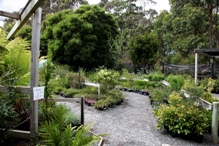
Click on the species name to get further information about the plant. There are also links to images and distribution maps.
The prices shown are for plants in tubestock - 50 mm forestry tubes or 75 mm round pots. Larger sizes are available for many species.
| Species Name | Common Name | Description | Price |
|---|---|---|---|
| Xanthorrhoea australis | Grass Tree | Very slow growing, but displaying a handsome, rounded spray of foliage in 4-6 years. Can flower in 10 years - expect a trunk over decades. Temperamental. Pot or sandy soil. Mature plants aren't available. We occasionally have other species. Images Distribution map | |
| Xerochrysum bracteatum | Golden Everlasting | Fast growing, bushy plant to 70 cm with large, shiny, crisp yellow paper daisy flowers. Expect a lifespan to 5 years. Images Distribution map G3-7, P4-7. | |
| Xerochrysum papillosum | St Mary's Everlasting | Fast growing, soft leaved plant to 60cm with large white paper daisy flowers in late spring and early summer. Can be hard pruned after flowering if required. Expect a lifespan of 2-5 years. Images Distribution map G3-7, P4-7. | |
| Xerochrysum subundulatum | Showy Everlasting | Quick, soft leaved plant to 60 cm from grassy areas of the central plateau and the north east. Crisp, yellow to orange flowers. Images Distribution map G3-7, P4-8. | |
| Xerochrysum sp. | Hybrid Everlasting | A similar plant to the other Xerochrysums, but of hybrid origin. Flowers can be white, yellow, pink, or somewhere in between. | |
| Xerochrysum sp. | Linda's Pink | A Xerochrysum cultivar with bright pink buds and flowers. Fast growing, soft-leaved plant to 60cm with large paper daisy flowers in late spring and early summer. Can be hard pruned after flowering if required. | |
| Xyris tasmanica | Tasmanian Yellow Eye | Low tufts of leaves. Three petalled yellow flowers on slender stems to 30 cm. Moist to wet position or pot. Will also grow in shallow water. Endemic to Tasmanian highlands and wet heaths. Images Distribution map G5-8, P6-9. |
|